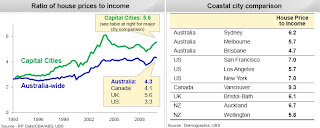And there really are some killer slides in this. The first slide below provides a simulation that assumes mortgage rates rise to 14%, unemployment hits 10%, while house prices fall by 30%.
On this basis, CBA reckons they would only incur losses of circa 0.2% of the value of their book. I wrote about this about a year ago, but CBA once again reiterate that the average outstanding home loan LVR is just 43%. That means there is 57% of equity or collateral sitting, on average, above their loans based on current valuations (CBA use very sophisticated statistical valuation technologies).
CBA also disclose that 70% of their customers are repaying ahead of their scheduled balance, while a standard interest rate buffer of 150bps is built into serviceability tests.
In the second slide CBA illustrate that the losses they incurred in 1991 when unemployment rose to 11% were tiny. The final slide employs Rismark's dwelling price to income ratios (using the median as opposed to the trimmed mean) to echo arguments previously made here. They are incorrectly referenced as RP Data.



